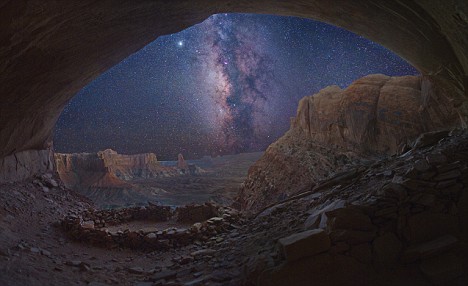
It looks like a lunar landscape but this remarkable photograph actually shows our Milky Way and the planet Jupiter in all their glory – viewed from a cave in America’s Utah desert.
The spiral galaxy, which cannot be seen with the naked eye, was captured by photographer Wally Pacholka using a 35mm camera and 50mm lens on a tripod with a 30-second exposure – long enough to collect the light but not to see the stars moving. He said: ‘I had to drive 800 miles each way five times to get the shot right. And I had to hike two miles to the cave and back again at night, getting lost each time I came out.’ His photo shows the Milky Way – estimated to be 100,000 light years in diameter and 1,000 light years deep – and Jupiter (to the top left), the biggest planet in the solar system with a diameter 11 times that of Earth’s.















I don’t know. I have seen a lot of astro-photography. Usually to get that much detail
and colors of the milky-way, the camera (or camera plus scope), it has to be a very long
exposure and on a polar mount that tracks as the
earth rotates. We are talking hours of exposure
time.
I used to be able to see it as a kid away from town.
No more.
I have done a very few time lapse pictures digital and otherwise and what you sometimes see can be shocking. As long as nothing moves things come clear.
It may be compared to filling up a bottle at a drip. It will fill up if you can give the time just as surely as turning on the tap full blast.
Of couse dim light sources you wouldn’t even notice become very bright.
The colors are because of the way the picture was taken. While most comments have talked at length about “Light Pollution”, and they are correct, they missed the other important part of it. The dust and humidity in the atmosphere.
If this was taken during a high pressure there would be no clouds. There would also be very little to no wind. The no wind means that no dust gets stirred up and what dust there is settles. Being taken in the desert means the air is very dry. While both dust and moisture will block star light, more important for night photography is they reflect man made surface light. That is the problem most amateur photographers face.
Taking the picture from inside the cave means that there is no side light to reflect off of the lens glass. As may be seen on the cliff walls, the moon puts out enough light to be quite noticeable. That would distort the final picture.
*
#30, Peter,
By extending to the limit I can see the trees using FireFox. Right click on the picture and VIEW IMAGE. Then “ctrl++” will enlarge it. The trees do become barely visible as dark shadows against the mottled dark sky. Do the same with the daylight picture you linked to in a separate tab. Looking in the same spot will show the trees.
Your linked picture is very beautiful.
*
A well executed picture. Something I would be very proud to have taken.
It looks like a painting.
I’m not an expert but I don’t think you can get a starfield like that with a 30 second exposure using a normal DSLR. It looks like a composite to me.
I hope he let the polygamists back in after he was done.
Nevertheless, the environment in Utah is one of the (few) reasons I live here.